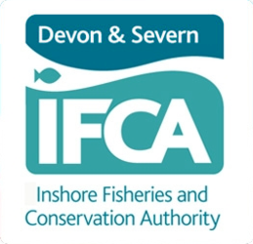Due to popular demand, D&S IFCA provides guidance about Minimum Conservation Reference Sizes that apply within its Byelaws.
This news item provides guidance on shellfish and fish sizes. The following guidance focusses on sizes, often referred to as Minimum Conservation Reference Sizes (MCRS), in particular the sizes that apply within D&S IFCA’s legislation. The guidance does not go into detail about species that can’t be removed from a fishery as part of D&S IFCA’s legislation, for example no removal of V-notched lobster.
D&S IFCA’s byelaws prohibit the removal of a range of species from a fishery within the District unless they meet the sizes (often referred to as minimum conservation reference sizes – MCRS). D&S IFCA has introduced four permit byelaws to regulate fishing activity. Fishers conducting these activities, shown in the table below, must have a permit*. The permit conditions for these four fishing activities include sizes for different species as shown in the table below. The permit conditions explain how to measure individual species, with use of diagrams and how the measurements are determined. For lobster and spiny lobster this is a carapace measurement. For crab and scallop this is a measurement across the broadest part of the carapace or flat shell. For whelk this is a measurement along the length of the shell. For bass this is a measurement from the tip of the snout to the end of the tail fin.
Permit Byelaws – Permit Conditions

Notes:
* A permit is not required for sand eel trawling if the vessel used in below seven metres in overall length. Other restrictions relating to sand eel trawling are set out in the Mobile Fishing Permit Byelaw.
** During July, August , and September a fisher operating with a Category One (commercial) Diving Permit cannot remove a scallop from a fishery within the District that is below 110mm measured across the broadest part of the flat shell. During July, August, and September, restrictions apply to fishers operating under a Category One Diving Permit relating to where in the District scallop measuring at least 110mm can be removed from.
Potting Permit Conditions – Live Wrasse Pot Fishery:
Potting for live wrasse is only permitted for fishers with a Category One (commercial) Potting Permit, and other restrictions apply including use of tags issued by D&S IFCA, a pot limit per fisher and specified gear marking requirements. The Potting Permit Conditions set out the size requirements (slot sizes) for ballan wrasse, corkwin wrasse, cuckoo wrasse, and goldsinny wrasse. Rock cook wrasse cannot be removed from a fishery in the District.
Angling & Bass
National legislation for bass applies to both commercial and recreational fishers with the minimum size for bass being 42cm. D&S IFCA has a website page setting out information relating to bass restrictions which can be viewed by clicking here.
D&S IFCA does not have a permit-based byelaws for angling, but some restrictions (minimum sizes of sea fisheries resources) in D&S IFCA’s inherited byelaws do apply to any person, regardless of what fishing activity is being conducted.
Anglers should be aware that some angling clubs may have introduced voluntary minimum sizes, and the Angling Trust encourages anglers to adopt a conservation minded approach. The Angling Trust has its own website page that has more information about minimum conservation reference sizes that apply around the UK, for example other IFCA byelaws, and sizes of sexual maturity for finfish species.
D&S IFCA’s Byelaw Book
D&S IFCA’s Byelaw Book includes the permit-based byelaws highlighted above, but also includes other byelaws with some that include restrictions relating to the size of sea fisheries resources. Relevant legacy byelaws (inherited from Devon Sea Fisheries) apply to any person, regardless of what fishing activity is being conducted, for example hand collection of shellfish. The D&S IFCA Byelaw Book website page can be viewed here. The sizes within the legacy byelaws are summarised below:
No person shall remove from a fishery:
- Scallop less than 100mm across the broadest part of the flat shell;
- Any winkle which will pass easily through a gauge within a square opening of 16mm measures over side of the square;
- Any edible female crab which measures less than 140mm across the broadest part of the back;
- Any edible cock crab which measures less than 160mm across the broadest part of the back;
- Any lobster less than 90mm (carapace length)
Other Inherited Byelaws
D&S IFCA also inherited byelaws from the Environment Agency. Those relating to the size of sea fisheries resources are only applicable to the Taw Torridge Estuary. These also apply to any person, regardless of what fishing activity is being conducted. The sizes within the byelaws inherited from the Environment Agency are summarised below:
No person shall remove from a fishery (Taw Torridge):
- Any oyster that will pass through a gauge having a circular opening of 21/4 inches in diameter;
- Any mussel of less than 2 inches length;
- Any cockle that will pass through a gauge having an aperture of ¾ inch square;
- Any edible crab measuring less than 41/2 inches across the broadest part of the back;
- Any lobster or crawfish measuring less than 9 inches from the tip of the beak at the end of the tail when spread as far as possible flat.
More Information
If you are a D&S IFCA permit holder, you can request a copy of your permit conditions by contacting D&S IFCA:
Permits@devonandsevernifca.gov.uk
If you require a permit to fish in D&S IFCA’s District you can apply online by clicking here.
If you have further questions about species that are prohibited for removal from a fishery that has not been explained in this news item (for example, a prohibition on the removal of berried lobster) please contact us.
